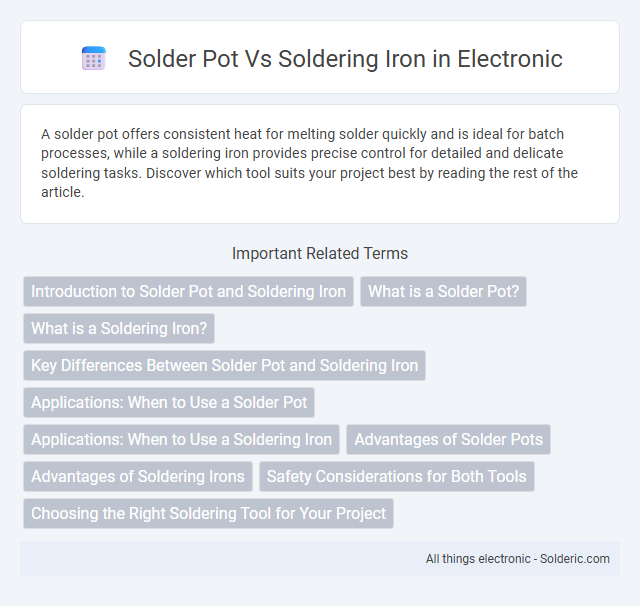A solder pot offers consistent heat for melting solder quickly and is ideal for batch processes, while a soldering iron provides precise control for detailed and delicate soldering tasks. Discover which tool suits your project best by reading the rest of the article.
Comparison Table
| Feature | Solder Pot | Soldering Iron |
|---|---|---|
| Purpose | Batch soldering of multiple components | Individual component soldering |
| Heating Method | Immerses parts in molten solder | Heats a metal tip for direct contact |
| Temperature Control | Usually adjustable thermostat | Variable temperature settings available |
| Application Speed | Fast for repetitive tasks | Slower, precise work |
| Best For | Soldering wires, terminals, PCB processing | Delicate circuits, small electronic components |
| Portability | Bulkier, less portable | Compact and portable |
| Cost | Generally higher initial cost | Lower price, widely affordable |
Introduction to Solder Pot and Soldering Iron
A solder pot is a heated container used to melt and hold solder for dipping components, enabling quick and consistent solder joints, while a soldering iron is a hand-held tool with a heated tip used to apply solder directly to individual connections. Each tool serves distinct functions in electronics assembly, with the solder pot ideal for mass soldering and the soldering iron suited for precise, manual work. Your choice between a solder pot and soldering iron depends on the scale and type of soldering tasks you need to perform.
What is a Solder Pot?
A solder pot is an industrial tool designed to melt and maintain a large quantity of solder at a consistent temperature, enabling efficient mass soldering processes such as tinning wires and component leads. Unlike a soldering iron, which uses a heated tip to apply solder locally, a solder pot immerses the components directly in molten solder to ensure uniform coating and strong mechanical bonds. Your choice between these tools depends on the production scale and precision required for your electronic assembly tasks.
What is a Soldering Iron?
A soldering iron is a handheld tool designed to heat and melt solder, enabling precise joining of electronic components or metal surfaces. It typically features a temperature-controlled heating element and a replaceable tip to accommodate various soldering tasks. Preferred for detailed work due to its portability and precise heat application, it contrasts with solder pots that provide bulk soldering solutions.
Key Differences Between Solder Pot and Soldering Iron
A solder pot is designed for batch soldering and maintaining molten solder at a consistent temperature, ideal for dipping multiple components quickly. A soldering iron offers precise, targeted heat for individual joints, making it suitable for detailed electronic work and repairs. Your choice depends on the scale and precision required, with solder pots excelling in volume and soldering irons in accuracy.
Applications: When to Use a Solder Pot
A solder pot is ideal for batch soldering processes, such as tinning multiple wires or small components quickly and uniformly, making it suitable for production environments. Your choice shifts to a soldering iron for precision tasks like circuit board repairs or delicate electronic assembly where controlled heat application is crucial. Understanding the strengths of each tool ensures efficient workflow, with solder pots excelling in speed and volume, and soldering irons offering accuracy and detail.
Applications: When to Use a Soldering Iron
A soldering iron is ideal for precision tasks such as electronic component assembly, circuit board repair, and detailed solder joints where accuracy and control are critical. It is best used in applications requiring small-scale, intricate work rather than continuous or high-volume soldering, which is suited for a solder pot. The soldering iron's compact size and pointed tip allow for targeted heat application on delicate components, making it essential for tasks in electronics manufacturing, DIY projects, and small repairs.
Advantages of Solder Pots
Solder pots offer consistent temperature control, enabling faster and more uniform soldering of multiple components simultaneously compared to a soldering iron. Their large molten solder reservoir reduces the risk of cold joints and improves efficiency in production environments. You benefit from increased throughput and repeatability when using solder pots for batch soldering tasks.
Advantages of Soldering Irons
Soldering irons offer precise temperature control, making them ideal for delicate electronic components and intricate work. They are portable and easy to handle, allowing you to perform detailed soldering tasks with accuracy. Their quick heating capability reduces downtime, enhancing productivity in both hobbyist and professional settings.
Safety Considerations for Both Tools
Solder pots offer consistent temperature control, reducing the risk of overheating and burns, but require careful handling of molten metal to prevent splashes and serious injuries. Soldering irons, while more precise for detailed work, pose risks of burns from prolonged contact and electrical hazards if not properly maintained. Your safety depends on using appropriate protective gear and following manufacturer guidelines for both tools.
Choosing the Right Soldering Tool for Your Project
Selecting the right soldering tool depends on the specifics of your project, with solder pots being ideal for batch processing and mass tinning of small components, while soldering irons offer precision and control for detailed work and repairs. Your choice should consider factors like temperature consistency, component size, and production volume. For intricate circuit boards or delicate tasks, a soldering iron provides accuracy, whereas a solder pot excels in efficiency for repetitive soldering tasks.
Solder pot vs soldering iron Infographic

 solderic.com
solderic.com